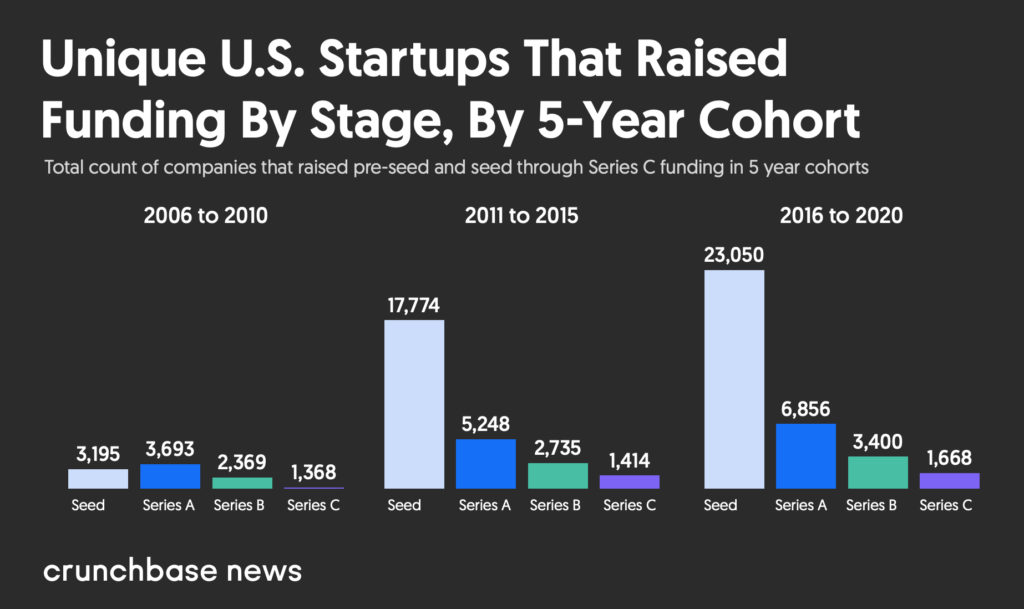Editor’s note: This is the first in a multipart series looking at seed funding trends.
Seed-stage funding to startups has exploded in the past decade and become an asset class of its own. If that wasn’t obvious already, consider that in just the past few months, three of Silicon Valley’s largest and best-known venture firms—Andreessen Horowitz, Greylock and Khosla Ventures—all announced large new dedicated seed funds.
Subscribe to the Crunchbase Daily
To visualize this dramatic change in the venture ecosystem and understand how much seed investment grew in the past 10 years, we decided to look at the number of U.S. startups that were funded over various five-year time frames and at different stages.
Crunchbase data underscores an impressive rise in funding to the smallest startups: Fewer than 3,200 companies received seed funding in the period between 2006 and 2010. A decade later, that had ballooned to more than 23,000 startups.

A brief history of seed funding
One of the biggest catalysts for new startup creation was the launch of Amazon Web Services and cloud computing in the early 2000s—new technologies that drastically reduced the cost and complexity of starting a new tech company. That, in turn, transformed seed funding into its own institutional asset class in the period between 2006 and 2010.
Still, startups that raised Series A funding continued to outpace startups raising seed until around 2009—when seed funding took the lead and began to explode, Crunchbase data shows.
Seed funding surged again in the period between 2011 and 2015, with 5x the number of companies funded at seed compared to the prior five years. By contrast, Series A-funded companies grew at a much slower pace, showing 42 percent growth.
By the 2016-2020 timeframe, there were 23,000 seed-funded companies in the U.S.—up another 30 percent compared to the prior five years. That put seed growth in line with the growth in Series A, where funded startups numbered over 6,800 during that five-year period—up 31 percent over the same period.
Rise of the VC seed investor
In the mid-2000s, venture firms accustomed to investing $3 million to $5 million at Series A and $8 million to $12 million at Series B weren’t all that interested in joining what looked like institutional angel rounds.
The Crunchbase numbers bear this out. From 2006 to 2010, multistage venture firms had seed investments in the single digits in total over five years.
But these VCs didn’t cede the seed stage for long. From 2011 to 2015, a number of leading multistage venture firms started to grow their seed practices, the most active of which were Andreessen Horowitz, New Enterprise Associates and Greylock.
As companies raised multiple seed fundings as well as larger seed rounds in the $1 million to $3 million range, larger venture firms seeking to be the first institutional investors became more invested at seed.

The firms investing in seed now
The most active multistage venture firms in seed investing more recently are Greycroft, Founders Fund and Khosla Ventures.
Khosla has raised multiple seed funds over time and was a seed investor in Instacart, DoorDash, QuantumScape and GitLab. Just this week, the firm announced the close of a new $400 million seed fund. That follows a $400 million seed fund the firm raised in 2014 and a $300 million seed fund in 2010.
Greylock, meanwhile, last month announced what the firm says is the largest pool of venture capital dedicated to seed investing: A new $500 million fund.
One of the reasons many venture firms are stockpiling funds to invest into seed startups is that getting in at the earliest stages with a young startup lets those investors have a say in crucial decisions early on.
“The ‘decision tree’ of a company has the most range at the beginning, and we want to be there as a partner to founders from the foundation,” Greylock, which has made seed investments in Wag, Instabase and Snorkel AI, said in its fund announcement.
Andreessen Horowitz announced a $400 million seed fund in August. The firm has made seed investments in Robinhood, Stripe and Lime over the years.
“While having a seed fund is not a shift in strategy—seed has long been a core focus—it underscores our commitment to seed investing as a first class motion for the firm,” Andreessen Horowitz said at the time.
Size of seed grows
We also looked at the median and average deal sizes for seed rounds for these 14 multistage funds over the decade, and found the median seed deal has grown from $1.5 million to $4 million, and the average from $1.7 million to $4.6 million.
While the size of the typical round has ballooned, there’s still a great deal of variance, however. In 2020, seed fundings from these investors ranged from $700,000 to $22 million.
The seed rounds of recent years are sizing up to look more like Series A fundings. “The imbalance between supply and demand has pushed round sizes and valuations to a point where investors are no longer rewarded for the risk they take, and seed rounds are now done at Series A prices and sizes from three years ago,” Jeff Clavier of Uncork Capital told me via email.
“The problem,” he added, “is that everyone is pricing deals as if they are a 10s of billions of dollars exit opportunity. The vast majority aren’t.”

Not just a side investment
Seed funding has exploded over the past 10 years, moving these investments into the venture mainstream.
Case in point: While seed investment was once sidelined as separate from a venture firm’s core focus—and therefore not subject to the same rules as its venture practice—some firms now require unanimous partner approval for their seed investments as well.
That’s the case at Sequoia Capital, whose Jess Lee I spoke to earlier this year on the announcement of the firm’s $195 million fourth seed fund. “Our seeds don’t get any different treatment than our Series As, except for there’s usually not an official board,” she said.
Crunchbase Pro queries relevant to this article
- U.S. seed funding since 2016
- Khosla Ventures seed investments since 2016
- Sequoia Capital seed investments since 2016
- Greylock seed investments since 2016
- Andreessen Horowitz seed investments since 2016
Methodology
For this analysis we include pre-seed and seed funding rounds. We exclude angel and equity crowdfunding.
The data contained in this report comes directly from Crunchbase, and is based on reported data. Data reported is as of Oct. 20, 2021.
Illustration: Li-Anne Dias

Stay up to date with recent funding rounds, acquisitions, and more with the Crunchbase Daily.










67.1K Followers